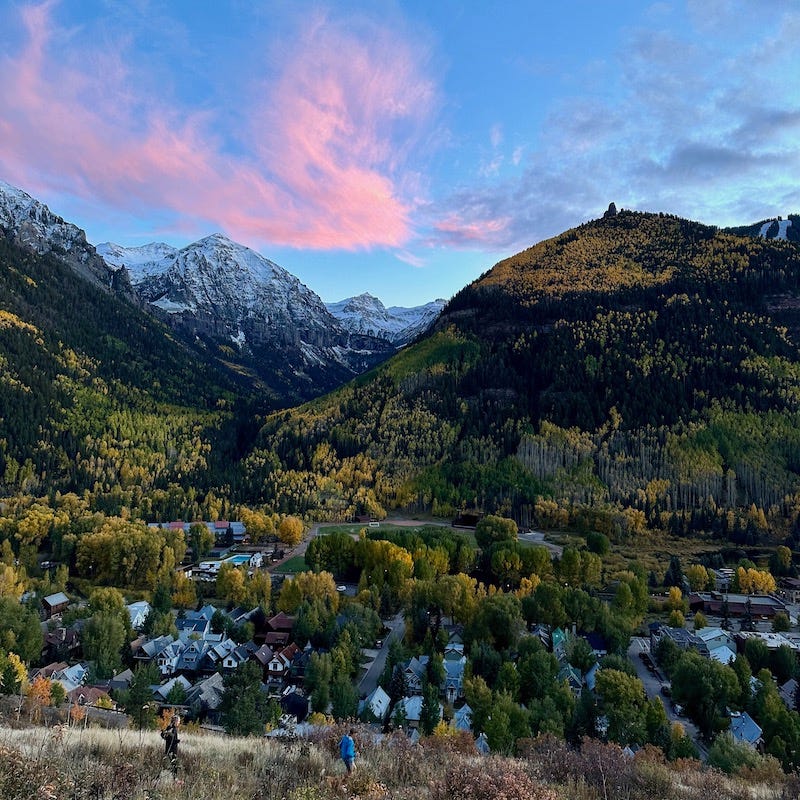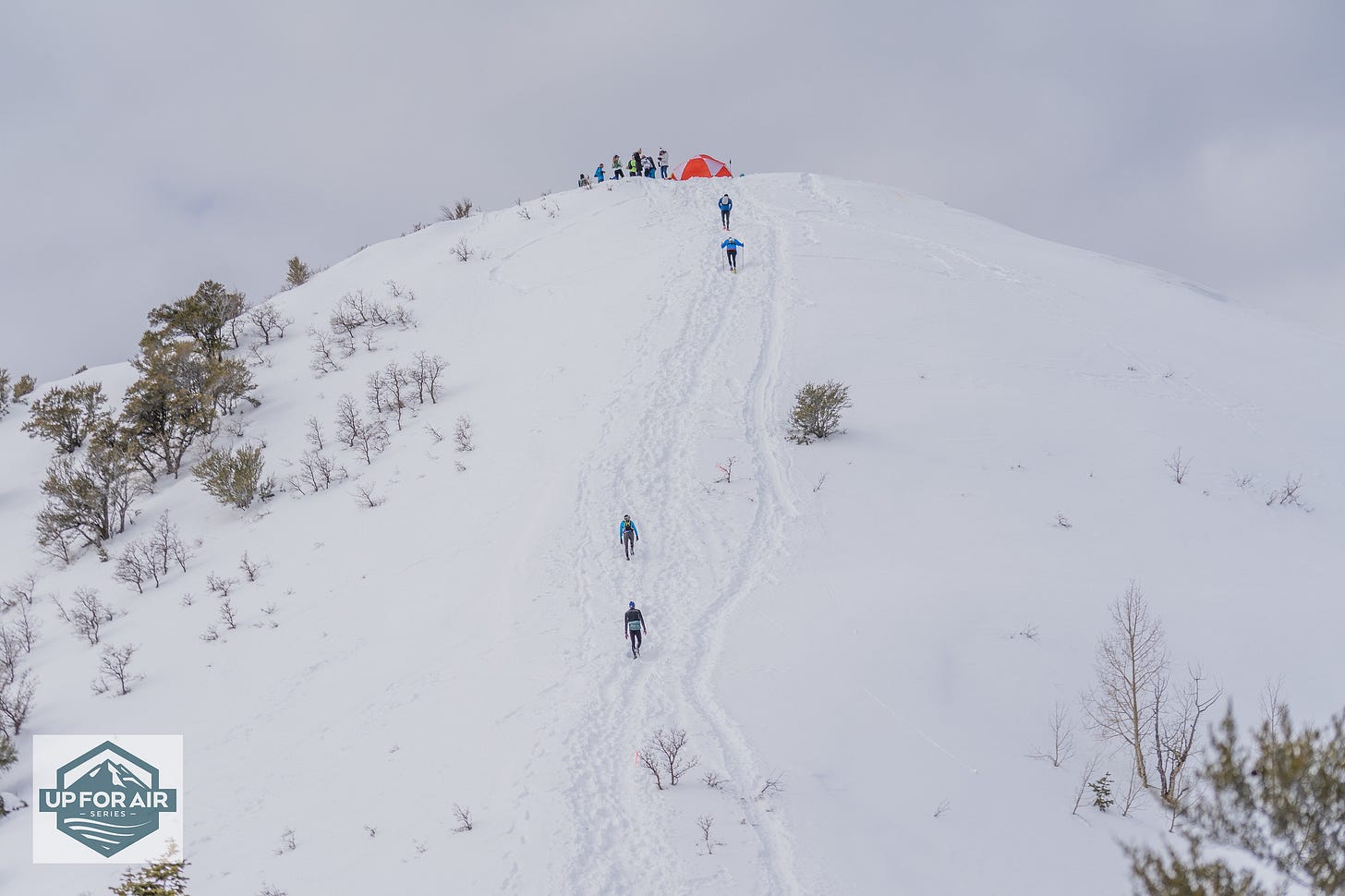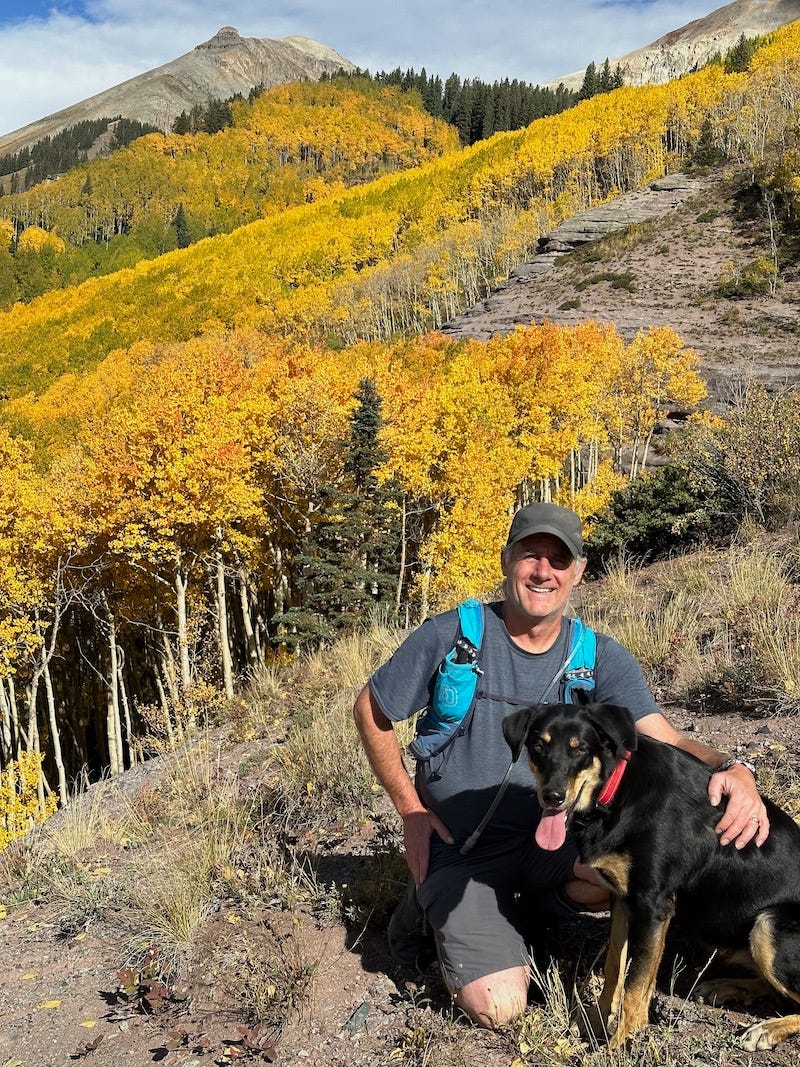Welcome to another hump-day edition. This week features some thoughts on recovery (the athletic, not sobriety, kind) and a story about going to CrossFit. First, here’s a shot from last night’s group run. Every Tuesday late afternoon, I come close to chickening out or blowing off this group run, because it’s uncomfortable to run at sunset when I’d rather be cozy at home cooking dinner, and because I’m one of the slowest and oldest in the group. Every time, I end up tapping into a reserve of energy and an ability to run better with the group than I would on my own. When you’re on the fence about running or going to a workout, remind yourself that you’ll feel better afterward. As a saying on a T-shirt I saw once at a race said, “‘I really regretted that run.’ - said no one ever.”

Taking a break and shifting to “maintenance mode”
We runners focus so much on the buildup to a goal race, but what do we do after the race? Someone asked me what my recovery looks like post-ultra and how I get back to running, so I’ll share that here.
Two-and-a-half weeks have passed since I ran the 100-mile Run Rabbit Run race, which took a little over 30.5 hours. In the one to three days immediately following, I felt extremely sleepy due to disrupted sleep, but not overly sore. I could walk up and down stairs without wincing, and no specific area experienced sharp pain. I just felt general all-over dull muscle fatigue.
Interestingly, I have felt a lot more sore—and had a much harder time walking down stairs—after a fast-paced road marathon than after this 100-mile trail run, which indicates that (1) I was well trained for this ultra, (2) I didn’t have any injury caused by overuse, asymmetry, or by a fall, and (3) the race was very low intensity (slow running with a great deal of hiking).
I bring this up because there’s no “rule” about how many days you should take off that corresponds to the distance of the ultra. If you’ve heard “take a day off for every 10 miles raced,” for example, forget it. Your soreness, fatigue, and need for rest post-race will depend on your individual fitness, your long-term running experience, and the terrain and intensity of the race you ran.
In the first week following RRR100, I prioritized sleep and healthy, hearty eating; did household and barn chores that got me moving in a gentle way; walked the dogs a mile or so at a time; and did a couple of yoga videos following Yoga with Kassandra on YouTube.
Normally, I take a break from running for about a week after a 100-miler—or longer, if I have a nagging injury that needs to heal—but this time, I went on my first post-race run four days later because I was obligated to show up to our local high school’s cross-country practice in my role as a paraprofessional helping a special-needs student on the team. I ran three easy, relaxed miles with some breaks along the way, and it felt fine, even good. I also did a basic low-impact strength workout that emphasized core and arm conditioning and went easier on the lower body.
The following weekend, as describe in last week’s post, I joined Hardrock’s women’s camp to hike and run for several hours on high-altitude trails. The three group runs added up to 21 miles with a lot of vertical gain and decent, which felt fatiguing in a good way, not stressful or painful. We went at a super casual, low-intensity pace. Some may think this is too much time-on-feet activity in the first week following a 100-miler, and for some it may be, but my body told me it felt OK as long as I got the sleep I needed.
A smart watch or device like an Oura ring also can help guide recovery with its health readings. I paid attention to my Garmin Fenix 7’s “Training Readiness” and “Body Battery” scores, which predictably tanked to zero post-100-miler and indicated a severe need to rest. Its Heart Rate Variability reading also went down to low, indicating my sympathetic nervous system (the “flight-or-flight” mechanism) was stuck in overdrive from the stress of the ultra. Gradually, these markers returned to normal and balanced over the period of about 10 days as I slept more and took my exercise relatively easy.
If you feel like you need a full break from running for an extended period post-race due to fatigue or burnout, or because you want to enjoy a different sport for the season, go for it! Taking a complete break from running for more than a week, however, isn’t for me. I need and crave the routine of running.
Starting last week, I shifted my running schedule into what I casually refer to as “maintenance mode.” That means I try to maintain a fitness base without stress or buildup, and try to prevent burnout. To do so, I cut out structured speedwork and long runs. I aim to run four to five times a week—the pace and effort level generally easy to steady—with a total weekly mileage around 30, with more crosstraining and conditioning in the mix. Generally speaking, I stop worrying about “training” and run for fun and by feel. I’ll stay in “maintenance mode” until I feel excited to build up for a new goal.
This post by Jason Koop, “7 Steps to Recovery After Running an Ultramarathon,” contains good basic advice. In my view, the key thing he points out has less to do with science and more to do with feeling. In answer to the question, “How will I know when it’s time to start training again?” he answers: “Emotion is the biggest indicator for me. An athlete is ready to go when he or she is excited to train again and feels physically fresh and energetic.”
I’m happy to report, I’m already feeling excited again and deliberately holding back so I don’t do too much, too soon. We’re traveling over Thanksgiving to a place that has a Turkey Trot race, and I feel like pushing myself in the 10K that day. I therefore want to do some speed sessions to tune up my legs but will wait a couple more weeks before adding some speed workouts back into the mix.
I also signed up for two unusual races in February and March that give me motivation to train in December and January (relying on a treadmill when winter weather makes running outdoors too uncomfortably cold).
The first is a 12-hour timed event on a snowy mountain that combines fast hiking uphill, using traction devices, with downhill running, repeatedly going up three miles and 2600 feet to a summit, then back down, as many times as possible in the 12-hour period. It’s the Salt Lake City event in the Running Up for Air Series, which I did in 2020, and it also features 6- and 24-hour divisions. I want to go back and try to beat or at least match the number of laps I accomplished the first time.
This is a special wintertime series, held in multiple cities, with the aim of raising money and awareness for clean air and climate initiatives. (Salt Lake City’s air quality in winter is awful, due to pollution and an inversion layer; runners break through the crust of pollution each time they ascend to the mountaintop.) Check out this article in UltraRunning magazine I wrote to learn more about it, and see the website for info on the other cities participating and their dates.

The second 2024 race I registered for is the Moab Run the Rocks three-day stage race in mid-March, with approximately 50 miles broken into three stages of 12, 25, and 13 miles. I’m not sure why, but the idea of running three days in a row and pushing my pace at each of those shorter distances appeals to me more than a single-day 50-miler this spring. (But if you’re looking for an amazing 50K or 50M in March, I highly recommend Antelope Canyon, which I wrote about here, taking place March 9.)
If you’ve reached the end of your racing season, give yourself time to chill out and focus on all-over wellness rather than on training. You’ll eventually start dreaming about and planning for the seasons to come, and then training for those goals will fall into place when you feel the stoke.
CrossFit first impressions
On Monday, I entered the Telluride CrossFit gym somewhat reluctantly.
I’ve always been skeptical of CrossFit. Its one-size-fits-all Workout Of the Day (WOD) seems antithetical to my belief in individualized coaching. Why adhere to a prescribed workout with a certain number of reps that work a certain body area, rather than do a conditioning routine that’s right for you according to your fitness level, your energy or fatigue level, and your personal training goals?
CrossFit struck me as a recipe for injury due to participants caught up in following the dictated workout with its specific reps while feeling a competitive urge to go heavier, since everyone’s stats for lifting are recorded on a wall for public viewing. Its adherents also seem religiously devoted. Maybe you’ve heard the joke: “How do you know if someone is into CrossFit? They’ll tell you.” (To be fair, that joke also could be adapted for, “How do you know if someone is training for their first marathon?”)
And do I even need CrossFit? I have my own routine at home, with dumbbells up to 25 pounds, plus “functional fitness” workout videos on iFit. But I want to lift heavier and learn new things. Like every person over 50, I should do resistance training to combat muscle loss, strengthen bones, and preserve mobility. Since I ran the 100-miler a couple of weeks ago, I’m entering a season with lower running volume, and therefore it feels like a good time to focus more on strength and mobility.
I went to Telluride’s CrossFit mainly because everyone I met who goes there has positive things to say about it. My sister-in-law, who would shy away from most gym scenes, loves it and has made friends there. One of her closest friends feels CrossFit saved her health and marriage, as described in this inspirational article (worth reading!), and has become a CrossFit coach. They assured me that Telluride’s CrossFit coaches modify the workouts to fit individuals’ needs.
I showed up early, before the instructor, and didn’t know where to stand and wait because the facility is so small, so I waited outside. The gym has no waiting area, no cubbies for street clothes or shoes, not even a water fountain. It’s typical of CrossFit’s no-frills, stripped-down, garage-style facility, called “a box,” not a gym.
The instructor arrived and welcomed me, and I joined others doing a warmup for mobility, using bands hooked to the wall to activate arms and shoulder blades, then monster walks with a band around my thighs. Our class had nine participants including me, plus the instructor, and we jostled for space. When it came time for a little bit of cardio warmup with jumping rope, my rope kept hitting equipment because I could barely find a rectangle of floor space to rotate the rope without getting in the way of others.
Then came the WOD. Monday’s WOD was all about using a barbell and doing reps of “cleans,” which involves pulling the barbell up from the ground to the shoulders. It sounds simple, but you have to be careful of your form or you could seriously jack your back and tweak your knees. I have never in my life used a barbell, only dumbbells, so I was game to learn. Before we could get started, however, the instructor spent a great deal of time explaining how to structure the 30-second intervals and how and when to add plates of weight to the barbell. It was complicated. All my warming up cooled off as I stood there. Finally, she started the clock, and we got to work.
I began with a 25-pound barbell, no weights, to get the hang of the movement. Then I gradually added plates up to 55 pounds total. It felt challenging but honestly, unsatisfying. I didn’t sweat, didn’t get my heart rate up very high, and didn’t feel my biceps working. I just experienced the sensation of my backside, especially glutes, working. I worried about my back and knees and therefore took each rep a bit more slowly than the others did them, to be extra careful. My hands, unaccustomed to gripping this much weight, started to feel sore.
Midway through, I thought, “OK, got it, what’s next?” But that was it—a long set of cleans, 60 total. No time for any other exercises. No core, no jumping around. I missed the HIIT classes I used to take at another gym, where we rotated to different stations. When class ended on the hour, my hands, back, glutes and hamstrings, and the back of my neck felt overworked, but nonetheless I kind of wanted to do a set of pushups, some planking, and go for a run to get the all-over workout and cardio I desired. We had spent the better part of the hour doing this one weird barbell movement over and over and over again.
But CrossFit changes its workouts each time. Every day there is different. Curiosity compels me to go back and see what other new thing I might learn and do there. Plus, I want to challenge myself in ways I can’t at home due to a lack of home equipment, such as performing an unassisted pull-up on a pull-up bar.
Ultimately, I’d like to maintain my home routine (detailed here in “Conditioning for Trail Runners: The Essentials”) at least once, ideally twice, per week, and maybe—jury’s still out—go to CrossFit one or twice a week, depending on my schedule. As long as it doesn’t wreck my back or knees.
Have you done CrossFit? Did you have a more enthusiastic first impression? Please share your experience in the comments below.
Update/postscript
I tried a second class the following week. It felt 10 times better, thanks to a more satisfying, interesting workout. It reminded me that a lukewarm first impression may be a natural reaction to trying something new. I bought a 10-class punch card and will commit to doing at least that many classes.
Earlier this week, I sent a bonus post to paid subscribers with a personal story—inspired by another runner’s incredible resiliency—about coping and getting through tough times.
You can receive bonus posts and an invitation to the monthly online chat by upgrading your subscription to the supporter level.
I understand, however, that many of you don’t want to commit to a paid subscription ($6/month or $60/year), and you might not want more posts in your inbox. But maybe, just maybe—like when you’ve particularly enjoyed or felt moved by a post—you occasionally want to express thanks for this newsletter in the form of a one-time tip. If so, this link or the button below is for you.
With this newsletter entering its third year, I decided to add a virtual tip jar through the “buy me a coffee” platform. If you want to support my writing with a one-time tip of 5 bucks, I’d love it and feel very grateful!
Finally, since I don’t have photos to illustrate the two stories above, I’ll end with a few pics from the past week.









I'm not a class type of person, I prefer to lift on my own during open gym hours and usually I have the entire gym to myself and sometimes one or two others are there. You're right, the gym is very small and when I go to open gym I'm always moving a rowing machine or some boxes out of my way so I can access the rack. But, I think Robin is building a new gym up the road (not sure where that's at in the building process). I did go to one cross fit class and swore I'd never go to another, so kudos to you for trying it out and giving it a shot. You're so good at going outside of your comfort zone and trying new things :)
I loved this article! This past year I trained for my first mountaineering trip and after the trip I didn’t want to think about another hike or run. I loved my training, but felt a bit burned out at the end. It’s been a little over a month and I’m slowly beginning to get excited about running again, so I loved the quote you included from Jason Koop that said, “emotion is the biggest indicator.” Thanks for sharing.